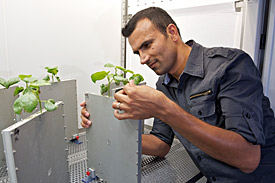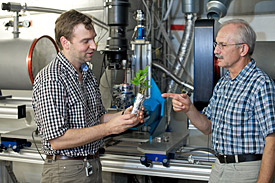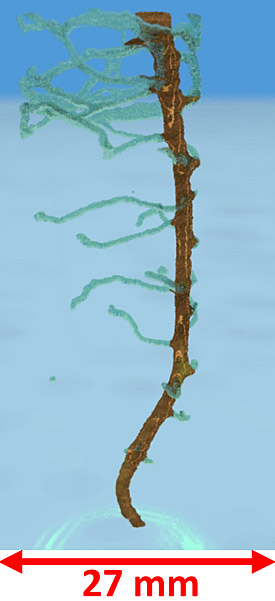Press release from September 15, 2011
Plants create a water reserve in the soil
Experiments performed at the Paul Scherrer Institute (PSI) reveal that a zone of higher water concentration exists around the roots of a plant.
It has long been known that roots alter the soil in their immediate vicinity, where other microorganisms live and the chemical composition is altered compared to that further away from the roots. An international research team has now demonstrated in experiments at the Paul Scherrer Institute that the soil in the vicinity of roots also contains more water - contrary to the earlier belief that there must be less water in this region, as the plant takes up water from the soil. Apparently, however, plants create a small water reserve that helps to tide them over through short periods of drought. These findings could help, in the long term, in the breeding of plants to cope better during periods of drought or in support of the development of efficient irrigation systems. These results were obtained from experiments carried out with the benefit of neutron tomography at the Paul Scherrer Institute, using a method that makes it possible to exactly show the distribution of water to a fraction of a millimetre, without having to remove a plant from the soil. The researchers have published their results in the prestigious journal New Phytologist.

Ahmad Moradi in front of the Climate Chamber in the experimental hall at SINQ, the PSI Neutron Source. Plants are raised here under natural conditions before being investigated.
Photo: PSI, M. Fischer

Sascha Oswald and Eberhard Lehmann at the PSI neutron tomography facility ICON, where the tomographic studies of the water distribution around plant roots were performed
Photo: PSI, M. Fischer

A three-dimensional representation of the roots of a chickpea plant. The image was obtained with the help of neutron tomography, by which the roots can be pictured through the soil.
Source: PSI
"The question of how plants take up water is not only relevant to the development of new, water-efficient strains of plants, but also for improving climate models", explains Sascha Oswald, from the Institute of Earth and Environmental Science at the University of Potsdam, “because typically more than half of all the water that falls onto the earth’s surface as rain in a humid climate is taken up by plants and then passes back to the atmosphere through the plants.” A research project at the Helmholtz-Centre for Environmental Research – UFZ where he worked with a number of colleagues had the goal of showing what exactly happens at the place where a plant takes up water through its roots. “Plants take water up from the ground by means of fine roots, a few millimetres in diameter. Their thicker roots serve more as pipelines, to relay the water. We want to understand the water distribution around these roots", explains Ahmad Moradi, from the University of California Davis.
Neutrons reveal water content without damaging plants
"The decisive processes occur here at a scale of a few millimetres. In order not to miss these processes, we need a procedure that shows details that are smaller than a millimetre and that can be applied without needing to remove the plant from the soil", says Moradi of the technical challenge. The researchers found the appropriate method at the Paul Scherrer Institute in the form of neutron tomography. Here, they were able to send neutrons through plants, together with the soil around their roots. Using these particles, it is possible to see inside different objects, in a similar manner to using X-rays but making different internal components visible. Specifically, neutrons are particularly attenuated and scattered away by water, whereas metal or sand are essentially invisible to them. "Roots consist to almost 90% of water. When one wants to examine them, or the movement of water in the soil, then neutrons are far better tools than X-rays", explains Moradi.
The researchers were thus able to create an exact three-dimensional image of the water distribution around the roots and determine how much water was present at different positions in the soil. "The microscope option of the facility was used for this measurement, so that images with a resolution of 20 pixels per millimetre could be generated. In this way, it was possible to make the water visible to the required accuracy", explains Eberhard Lehmann, whose group operates the facilities at PSI. "We have three measurement stations at which we can create images with neutrons - each with its own characteristics. Thus we were able to try out different options for the experiment. A great advantage of the PSI facility is also that it is in operation 24 hours a day, and thus plants could be observed over a complete day-night cycle." PSI is the only centre in Switzerland at which neutrons are available for research.
More water at the roots
The result obtained from this study is that the soil in a region within a few millimetres from roots contains about 30% more water than the rest of the soil. It has long been known that roots significantly alter their immediate environment. In this so-called rhizosphere a much higher number of different microorganisms than elsewhere can be found. They profit from organic root excudates. "Because of the water uptake by roots it has been assumed as a matter of course that the water content close to the roots is decreased and that water is flowing along a gradient towards the roots", explains Hans-Jörg Vogel from the Department of Soil Physics at UFZ. The experiments contradicted this belief, for all three types of plants tested - maize, lupines and chick peas.
Water reserve for bad times
"We can now only speculate about the question as to how the water concentration around the roots becomes higher. It is probable that a gel-like substance that the roots exude is responsible. This substance can absorb 10,000 times its own dry weight of water. In this way, plants could create an emergency supply for short periods of drought", explains the soil physicist Andrea Carminati, from the University of Göttingen. Even if this emergency supply does not suffice for longer periods of drought, it can help cover periods of up to 12 hours in which the plant would otherwise be cut off from a supply of water. "If one thinks about the practical applications of these results, then they can help in the breeding of plants which can survive dry periods better. One could also learn exactly how much to water plants, so that they do not come to long-lasting harm through drying out", adds Sascha Oswald.
The project
This research project was carried out by scientists from the Helmholtz Centre for Environmental Research - UFZ, the University of California Davis, the University of Potsdam and the University of Göttingen, who had all previously worked together at the UFZ. The experiments described here were performed at the Paul Scherrer Institute, PSI (Villigen, Switzerland) and supervised by PSI scientists.
Publication
Moradi, A.B., Carminati, A., Vetterlein, D., Vontobel, P., Lehmann, E., Weller, U., Vogel, H.-J., Oswald, S.E. (2011):
Three-dimensional visualization and quantification of water content in rhizosphere. New Phytol.
http://dx.doi.org/10.1111/j.1469-8137.2011.03826.x
Further information
Dr. Ahmad Moradi
Department of Land, Air and Water Resources
University of California Davis, Davis, CA 95616, USA
amoradi@ucdavis.edu
Telephone: +1 530 752 1210
Dr. Eberhard Lehmann
Group Leader of Neutron Imaging, Paul Scherrer Institut
5232 Villigen PSI, Switzerland
eberhard.lehmann@psi.ch
Telephone: +41 56 310 29 63
Prof. Dr. Sascha Oswald
Institute for Earth and Environmental Science, University of Potsdam
14476 Potsdam-Golm, Germany
sascha.oswald@uni-potsdam.de
Telephone: +49 331 977 2675
Dr. Andrea Carminati
Department of Crop Sciences, Georg-August-University of Göttingen
37018 Göttingen, Germany
acarmin@uni-goettingen.de
Telephone: +49 551 39 4629
Prof. Dr. Hans-Jörg Vogel
Helmholtz-Centre for Environmental Research (UFZ), Department Soil Physics
06120 Halle, Germany
hans-joerg.vogel@ufz.de
Telephone: +49 345 558 5403
or
Tilo Arnhold
Helmholtz-Centre for Environmental Research (UFZ)
Public Relations
Telephone:: +49 341 235-1635
tilo.arnhold@ufz.de
At the Helmholtz Centre for Environmental Research (UFZ), scientists study the causes and repercussions of far-reaching environmental changes. They conduct research into water resources, biodiversity, the consequences of climate change and ways of adaptation, environmental engineering and biotechnology, bioenergy, how chemicals behave in the environment and their impact on human health, modelling, and aspects of the social sciences. The common theme of this diverse research is that it serves the sustainable use of natural resources and helps permanently protect these vital resources in the face of global change. At its sites in Leipzig, Halle and Magdeburg, UFZ currently employs about 1,000 people. It is financed by the German government as well as the governments of Saxony and Saxony-Anhalt.
The Helmholtz Association helps solve major, pressing challenges facing society, science and industry by means of first-rate research in six core fields: Energy, Earth and the Environment, Health, Key Technologies, the Structure of Matter, Transport and Space. With more than 30,000 employees at 17 research centres and an annual budget of some €3 billion, the Helmholtz Association is Germany’s biggest scientific organisation. Its work continues the heritage of scientist Hermann von Helmholtz (1821-94).
